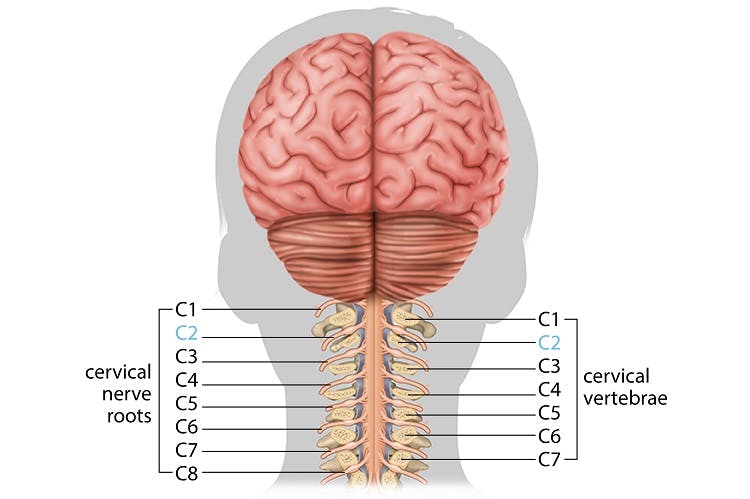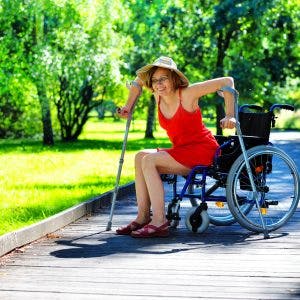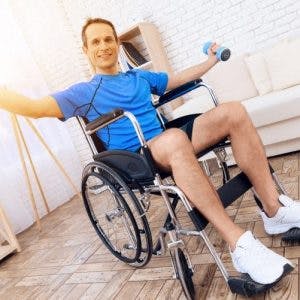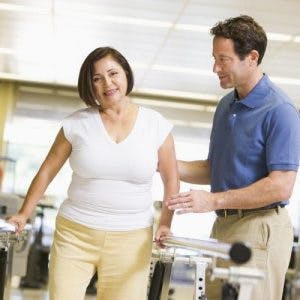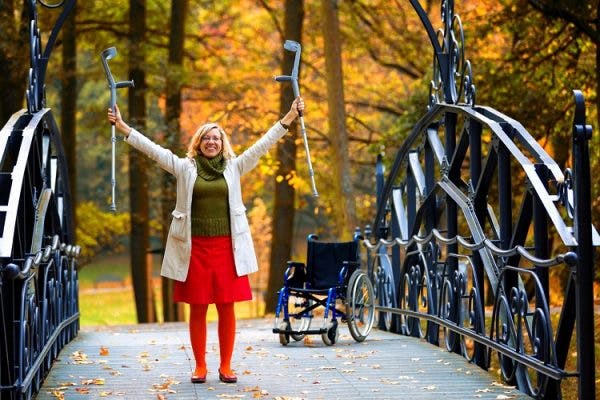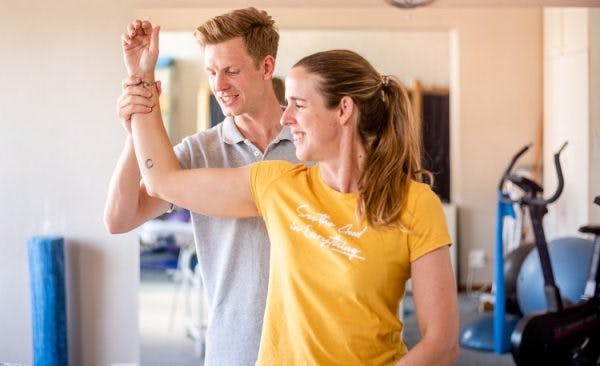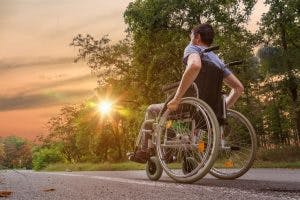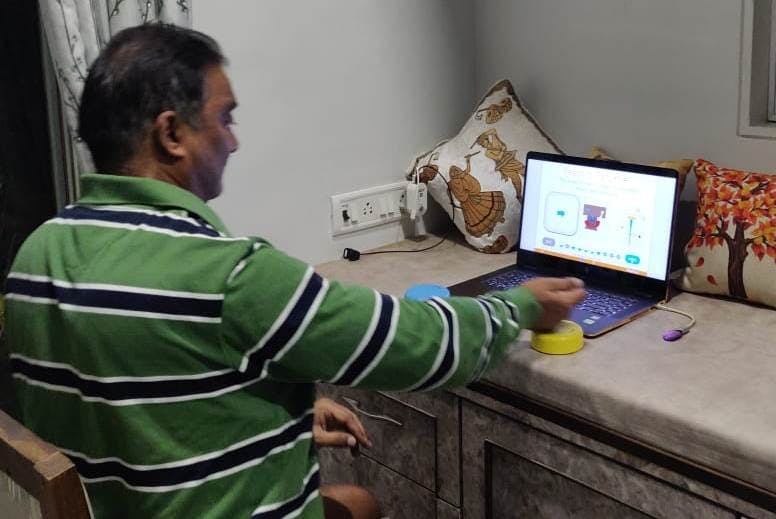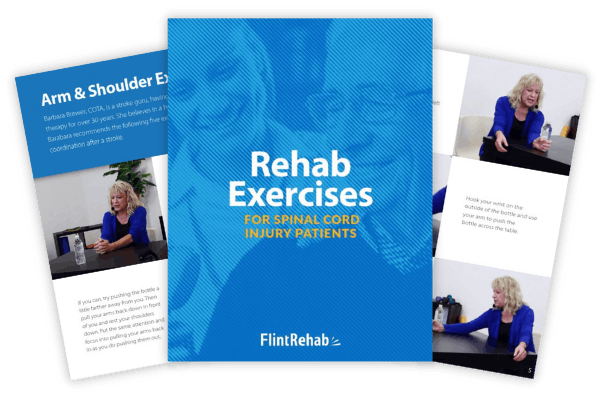A C2 spinal cord injury is a serious condition involving damage to the upper portion of the cervical region of the spinal cord. The spinal cord is a delicate bundle of nerves that transmits messages between the body and brain. Damage at the C2 level can significantly affect motor control and sensation throughout the entire body.
To help survivors and their families better understand what to expect after a C2 spinal cord injury, this article will discuss which functions can be affected at this level of cervical spinal cord injury. Various rehabilitative interventions that can promote recovery will also be discussed.
Use the links below to jump straight to any section of this article.
- Anatomy of the cervical spinal cord
- Factors affecting spinal cord injury outcomes
- Functions affected
- Treatment options
- Recovery outlook
- A day in the life
Anatomy of the Cervical Spinal Cord
The spinal cord is a bundle of nerves that connects the brain with the rest of the body. It is protected by the spinal (or vertebral) column, which is made up of 33 vertebrae spanning from the base of the skull to the tip of the tailbone.
As the spinal cord travels through the spinal column, 31 pairs of spinal nerves exit to the right and left sides of the body. These nerves carry messages about the body’s sensation and movement to and from the brain.
Since the spinal cord transmits information between the brain and the rest of the body, it is a vital portion of the nervous system. When the spinal cord becomes damaged, sensory and motor functions throughout the rest of the body may be affected.
The spine is divided into five regions. The top region, located in the neck area, is referred to as the cervical spine. Within this region there are 7 vertebrae and 8 pairs of spinal nerves, which exit between the vertebrae.
The first cervical vertebra is referred to as C1 or the atlas, while the second cervical vertebra is referred to as C2 or the axis. These two vertebrae make up the top of the spinal column. They are essential for supporting the skull, providing neck mobility, and protecting the spinal cord.
The junction where the skull and the C1 vertebra meet forms a joint that allows the head to nod. Conversely, the joint between the C1 and C2 vertebrae allows the head to turn left and right.
The spinal nerves at each level of the spinal cord connect to, or innervate, a specific area of skin for sensation and set of muscles for movement. The C2 nerves carry information regarding sensation of the top and back of the scalp, the ear lobes, and the front of the neck. They also carry messages to the muscles involved with neck flexion (nodding).
Factors Affecting Spinal Cord Injury Outcomes
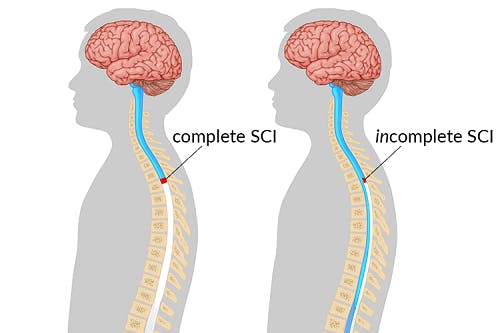
There are two main factors that influence the effects of a spinal cord injury: the level of injury and its severity.
Level of Injury
The level of injury refers to where the damage to the spinal cord occurred. Each pair of spinal nerves connects to a different area of the body. Generally speaking, higher-level spinal nerves carry information regarding the upper body, and lower-level spinal nerves carry information regarding the lower body.
Since information cannot be passed through damaged areas of the spinal cord, the level of injury is considered the last level of the spinal cord where associated functions are left intact.
Survivors of a high-level spinal cord injury may lose sensation and movement of the majority of their body. Those with a lower-level injury may retain control of the upper portion of their body, while experiencing a loss of functions in the lower body.
Severity
The severity of a spinal cord injury is determined by how completely the spinal cord is severed. During a complete injury to the spinal cord, signals from the brain cannot pass through the lesion, meaning that all functions innervated below the level of injury will be interrupted.
On the other hand, during an incomplete spinal cord injury, some connections within the spinal cord remain intact. This allows some sensory and/or motor information to still be transmitted, meaning that not all sensation and/or movement below the level of injury will be affected.
Since there are some existing neural connections in the spinal cord, those with incomplete SCIs have a greater likelihood of recovering lost functions. Functional outcomes can vary significantly depending on the level and severity of the injury.
Functions Affected by a C2 Spinal Cord Injury
Depending on the injury’s severity, C2 spinal cord injury survivors may experience a wide variety of functional outcomes. Here are some of the major functions that can be affected by a C2 SCI.
Breathing and Speaking
Individuals with C2 spinal cord injuries may experience difficulties breathing independently. This is due to impaired function of the diaphragm, the main muscle responsible for respiration. As a result, C2 SCIs are often fatal and require immediate medical attention. Many need the assistance of a ventilator to breathe and may consequently struggle to speak.
Sensation Below the Neck
Individuals with C2 spinal cord injuries can experience impaired sensation from the neck down.
Sensory information travels from the body through the nerves and up the spinal cord before reaching the brain. Then, the brain processes that information and reacts. For example, when you touch something hot, sensory information travels to the brain and the brain sends a message to muscles, telling them to move your hand.
After a C2 SCI, sensory messages from the neck down may not be able to reach the brain, resulting in loss of sensation throughout the entire body, with the exception of the head. This can be extremely dangerous and requires survivors and their caregivers to be more mindful of potential hazards in the surrounding areas.
Paralysis from the Neck Down
A C2 spinal cord injury may result in quadriplegia (paralysis of the upper and lower limbs). Since the arms, legs, and trunk may all be affected, survivors of severe C2 SCIs generally need full-time caregiver assistance to perform activities of daily living, such as eating, dressing and moving in bed.
Some complications that can result from being paralyzed from the neck down include:
- Development of pressure sores. If survivors sit or lie in the same position for extended periods, the prolonged pressure can result in skin irritation and breakdown. Ensuring that the survivor changes position at least every 2 hours can reduce the likelihood of pressure sores developing.
- Changes in body composition. Paralysis from the neck down results in muscle atrophy, which means that the muscles shrink from lack of use. Loss of muscle mass can affect circulation, slow the metabolism, and increase susceptibility to further injuries.
- Bladder and bowel dysfunction. The lowest level spinal nerves connect to the bowel and bladder muscles. Therefore, most spinal cord injuries will result in at least some bladder and bowel problems. As a result, C2 spinal cord injury survivors often need to utilize catheterization and other bladder and bowel management techniques.
While these effects of spinal cord injury can greatly affect one’s life, there are numerous treatment options available to manage the effects of C2 SCI and promote recovery.
C2 Spinal Cord Injury Treatment
While damage to the spinal cord cannot be reversed, individuals with C2 spinal cord injuries can improve their quality of life. This can be accomplished by minimizing the progression of damage, maximizing functional abilities, and, in the case of those with incomplete injuries, promoting neuroplasticity.
Immediate treatment for a C2 spinal cord injury generally involves two components:
- Restoring respiratory function. The most urgent priority when treating a C2 spinal cord injury is stabilizing respiratory function. Individuals with complete C2 SCIs have high mortality rates due to impaired diaphragm function. Without immediate medical attention, individuals may be unable to breathe. With the help of a ventilator, respiratory functions may be restored.
- Stabilizing the spinal cord. Depending on the severity of one’s C2 spinal cord injury, decompression surgery may be required to reduce pressure on the spinal cord. Corticosteroids like Methylprednisolone may help reduce inflammation, which can contribute to minimizing the progression of secondary damage.
After the emergent effects of a C2 SCI have stabilized, survivors are encouraged to start rehabilitation. Because a C2 spinal cord injury can cause paralysis throughout the body, rehabilitation focuses on identifying preserved functions and maximizing their potential.
Rehabilitation after a C2 SCI can consist of:
Physical Therapy
Physical therapy helps survivors improve their functional mobility through targeted exercises. Especially helpful for those with incomplete spinal cord injuries, physical therapy may include manual techniques, electrical stimulation, and active and passive exercises to maximize mobility and promote recovery.
Occupational Therapy
Occupational therapy teaches survivors and their caregivers how to manage everyday life after SCI. This can involve caregiver training to learn how to most safely and easily complete daily tasks, such as performing transfers, getting dressed, or completing bowel and bladder management programs. They may also address safety concerns regarding sensation deficits. Occupational therapists often recommend adaptive devices and assistive technology, such as voice activated or eye gaze-controlled devices, to optimize independence.
Speech Therapy
Speech therapy can be an essential component of rehabilitation after a C2 spinal cord injury. Speech therapists may address difficulties with breathing and voice projection through respiratory muscle training. Practicing breathing exercises can help improve lung capacity and residual volume to improve ease and efficiency of breathing. Likewise, coughing exercises may help improve your ability to clear lung secretions. For individuals who are unable to project their voices well enough to be heard, speech therapists may recommend augmentative and alternative communication (AAC) devices, which may rely on eye blinks or gaze to operate.
Psychotherapy
Living with a C2 SCI can be just as much a mental challenge as it is a physical one. Psychotherapy can help you cope with the emotional and psychological effects of SCI. Survivors and their family members can also benefit from participation in a support group for this reason.
Medical Equipment Providers
Many C2 SCI survivors work with a medical equipment provider to ensure they have the appropriate devices for day-to-day life. Medical equipment providers often work in conjunction with a therapist in order to recommend equipment such as a power wheelchair, pressure-relief mattress, and orthotics. Orthotic devices like braces or splints provide structural support that can help you sit upright, lightly stretch spastic (tight) muscles, and improve alignment.
Each of these areas of rehabilitation can be important components to promoting recovery after a C2 spinal cord injury.
Want 15 pages of SCI recovery exercises in PDF form? Click here to download our free SCI Rehab Exercise ebook now (link opens a pop up for uninterrupted reading)
Recovery Outlook Following a C2 Spinal Cord Injury
Many individuals with C2 spinal cord injuries learn to adapt and/or improve their mobility and sensation by participating in a rehabilitation program. Individuals with incomplete spinal cord injuries have a better recovery outlook in terms of recovering affected functions than those with complete spinal cord injuries.
This is because those with incomplete SCIs have some remaining neural connections left intact, allowing some communication between the brain and the rest of the body to occur even below the level of injury. The spinal cord is able to optimize its function through these existing connections through a process called neuroplasticity.
Neuroplasticity refers to the central nervous system’s ability to adapt, rewire and repair itself. In the case of spinal cord injuries, neuroplasticity allows the transmission of information regarding affected functions to be rewired to a healthy area of the spinal cord.
Neuroplasticity is best promoted through repetitive exercises and activities. Therefore, participation in a rehabilitation program, and carrying over exercises using a home exercise program, is a great way to promote recovery.
Although those with complete spinal cord injuries are unable to utilize neuroplasticity, they can learn to adapt using compensatory strategies. While conventional rehabilitation cannot help those with complete spinal cord injuries regain function, many researchers are looking to remedy this.
Methods such as stem cell therapy and epidural stimulation are currently being researched as options to help those with complete spinal cord injuries achieve a better recovery outcome.
A Day in the Life of a C2 Spinal Cord Injury Survivor
It can be hard to picture what the life of a C2 spinal cord injury survivor would look like. Although being paralyzed from the neck down can limit what C2 SCI survivors can complete independently, they can still find ways to live productive, fulfilling lives.
Most individuals with C2 spinal cord injuries require caregiver assistance for getting out of bed, dressing, showering, and managing bowel and bladder needs. If set up appropriately, survivors can drink water or a smoothie independently using a straw. They could choose to chat, look outdoors, or read on a device while eating their breakfast.
After getting ready for the day, many survivors are able to use an eye-gaze controlled power wheelchair to move independently throughout their home and community. They can communicate either verbally or using a communication device.
Typically, survivors have an attachment on their power wheelchair to allow them to see and use their communication device or a gaze-controlled tablet. Throughout the day, survivors are recommended to frequently change position to relieve pressure from the bony parts of their body by utilizing a tilt-in-place function on their wheelchairs.
Some C2 survivors may continue working. Others may pursue therapy or engage in recreational activities, such as online gaming or reading. Still others, especially if they have regained some function, could explore a national park using a rental track chair.
Although a C2 spinal cord injury can drastically change the life of the survivor, there are many ways to continue to engage in and enjoy life.
For example, Christopher Reeve, an actor best known for his role as Superman, sustained a C2 spinal cord injury at the age of 43. After his injury, he vigorously pursued rehabilitation. He also continued working, directing multiple movies and publishing a few books. However, arguably his most important role after his injury was establishing the Christopher Reeve Foundation, an organization focused on spinal cord injury research, advocacy, and support.
Although life may be different after a C2 spinal cord injury, there are many ways to adapt and lead an engaging and fulfilling life.
Understanding C2 Spinal Cord Injury
A C2 SCI can affect movement and sensation from the neck down. However, depending on the severity of their injury, survivors may be able to move and feel areas innervated below their level of injury.
After stabilizing the initial injuries, survivors can pursue rehabilitation to manage and improve their functions. Life may look different after a C2 spinal cord injury, but it can still be very fulfilling.

